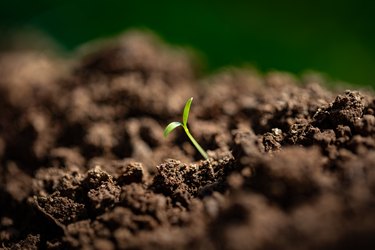
The cohesion of soil definition is the tendency for particles of soil to stick together. Cohesive soils, such as clay and peat, tend to stick together, while noncohesive soils, such as gravel and sand, have easily separated particles. Cohesiveness is not dependent on external forces and is one measurement to consider when evaluating the type and quality of the soil.
Types of Cohesive Soils
Video of the Day
When you look at a cohesion of soil table, you will see that clay is generally the most cohesive soil and has very fine particles. Compacted soil also tends to be more cohesive compared to looser soil types. Some other types of cohesive soil include loam, silt loam, clay loam, silts and clayey sand and gravel. Noncohesive soil types include sands, gravels with few fine particles and silty gravel.
Video of the Day
Soil cohesion is measured in kilopascals (kPa), which is a measurement of pressure. The cohesion of soil values can be as low as 0 kPa for noncohesive soils, while the compacted clay cohesion value may be over 100 kPa.
Factors That Affect Soil Cohesion
What is cohesion in agriculture? Soil cohesion helps to show how much water a certain soil type can hold, as water is the factor that helps cohesive soils bind together. Cohesion in soil mechanics occurs when the water molecules, which have a slight positive charge around the oxygen molecules and a negative charge around the hydrogen molecules, are attracted to the positive and negative molecules on the soil particles.
When the particles are small enough, the water binds them together. When the particles are larger, as with gravel particles in noncohesive soils, the water doesn't bind the molecules and flows through the soil. Some soils are a mixture of particle types, which can further affect cohesiveness. While gravel, for example, is usually noncohesive, clayey gravel will have some measure of cohesiveness.
Besides this cohesive strength, cohesive soils also have the characteristic of plasticity. Plastic soil has the consistency of putty and can be molded without breaking or cracking. Wet clay, for example, is plastic when it is wet, while loam is only slightly plastic. Soil that contains clay, such as silty, sandy or loam clay, is also plastic when it is wet. When these soils dry, they become quite hard.
Cohesion in Soil Science
Soil cohesion and the amount of water soil holds is important in agriculture. While the home gardener doesn't need to know the specific measurements, it is important to know how the soil in your garden will affect the growth of your plants. For example, if you have sandy soils, you know the soil will dry faster, and your plants may need additional water. If you have clay soil, you know that the soil can be heavy and wet, which makes it difficult for plants to thrive and root.
This measurement is also an important consideration in many other industries. For example, in drilling, the tool used to penetrate the soil may vary depending on the type of soil and the cohesiveness of the soil. Engineers also need to consider soil cohesion when developing building plans to ensure they design structures and foundations that will last on a certain soil.
- Engineers Edge: Soil Cohesion Table
- IOP Conference Series: Earth and Environmental Science: Evaluation of the Parameters Affecting the Cohesion of Fine Grained Soil
- University of California Santa Cruz: Soils and Soil Physical Properties
- Borehole Solutions Limited: What Is The Difference Between Cohesive And Non-Cohesive Soils?